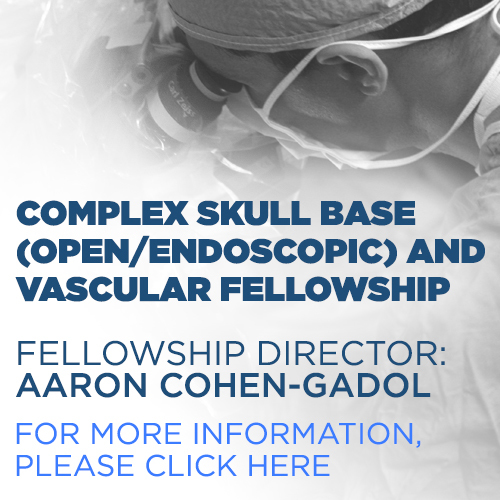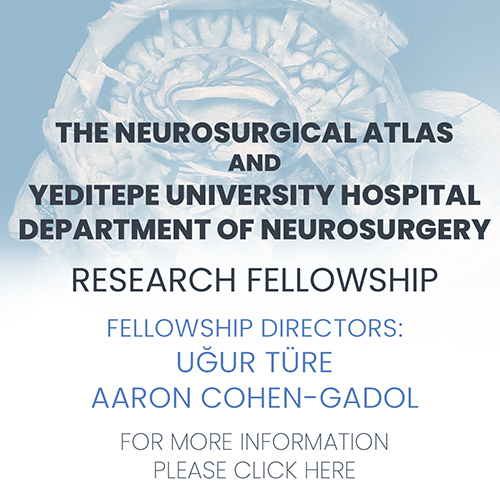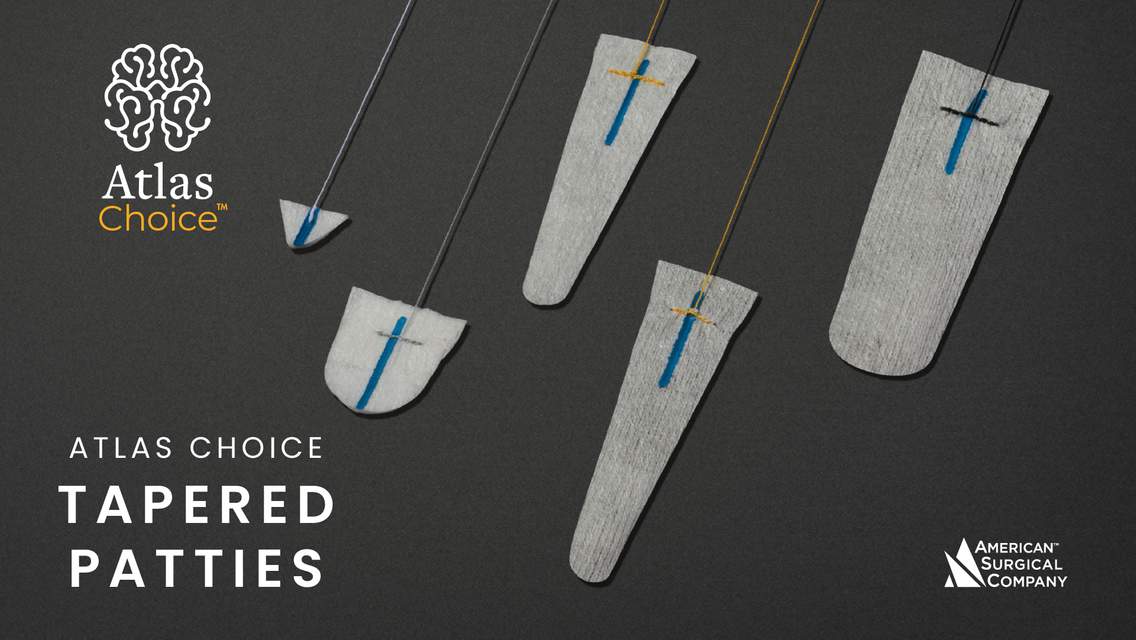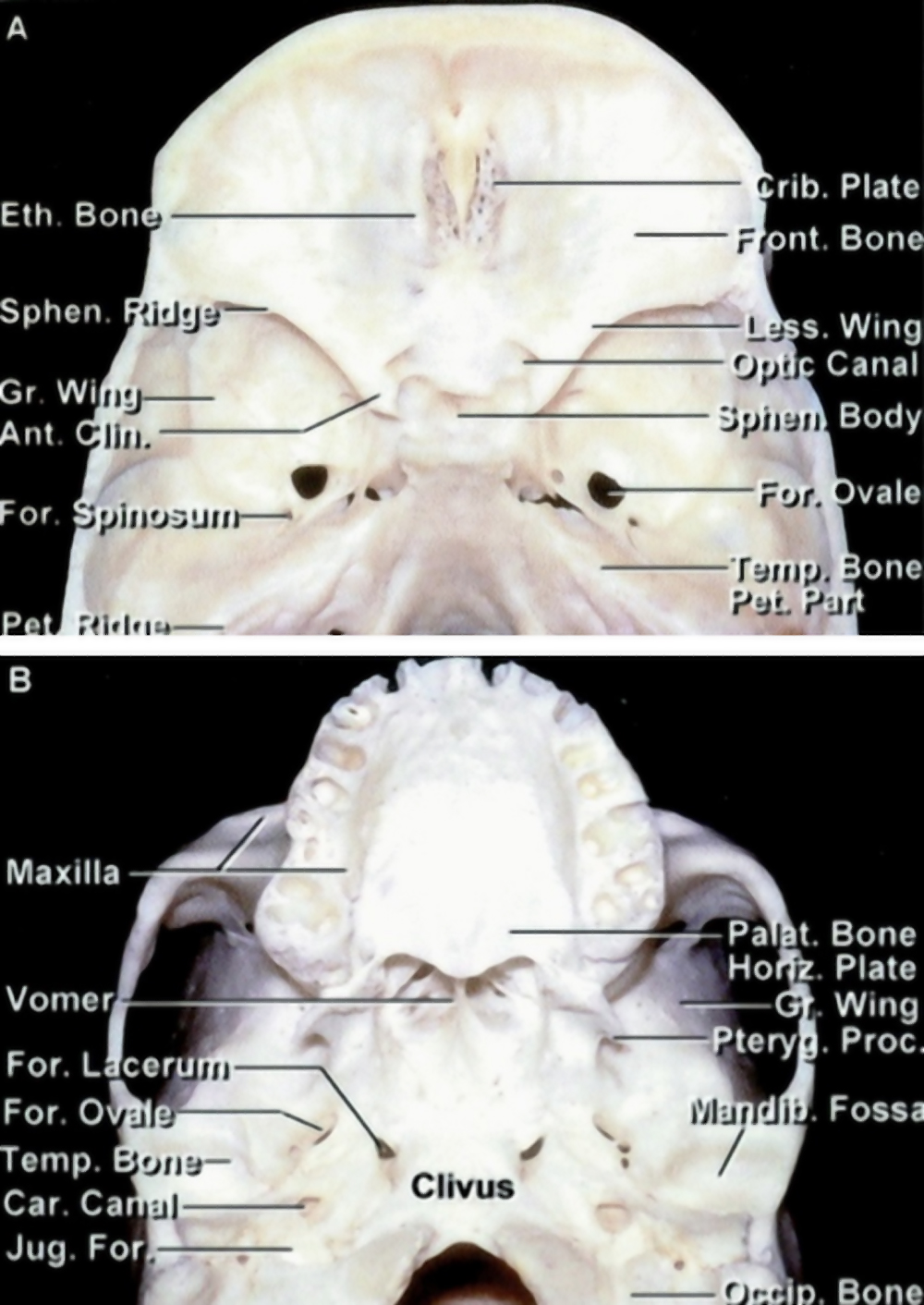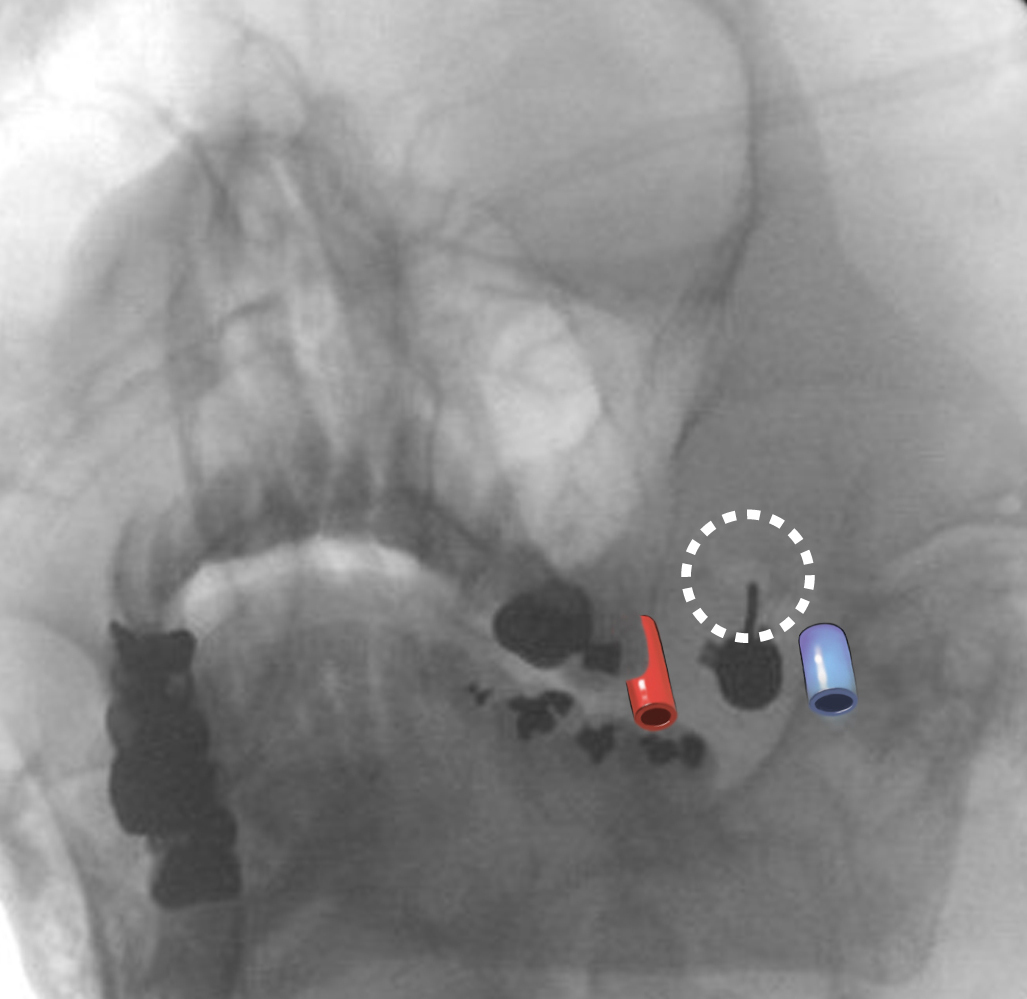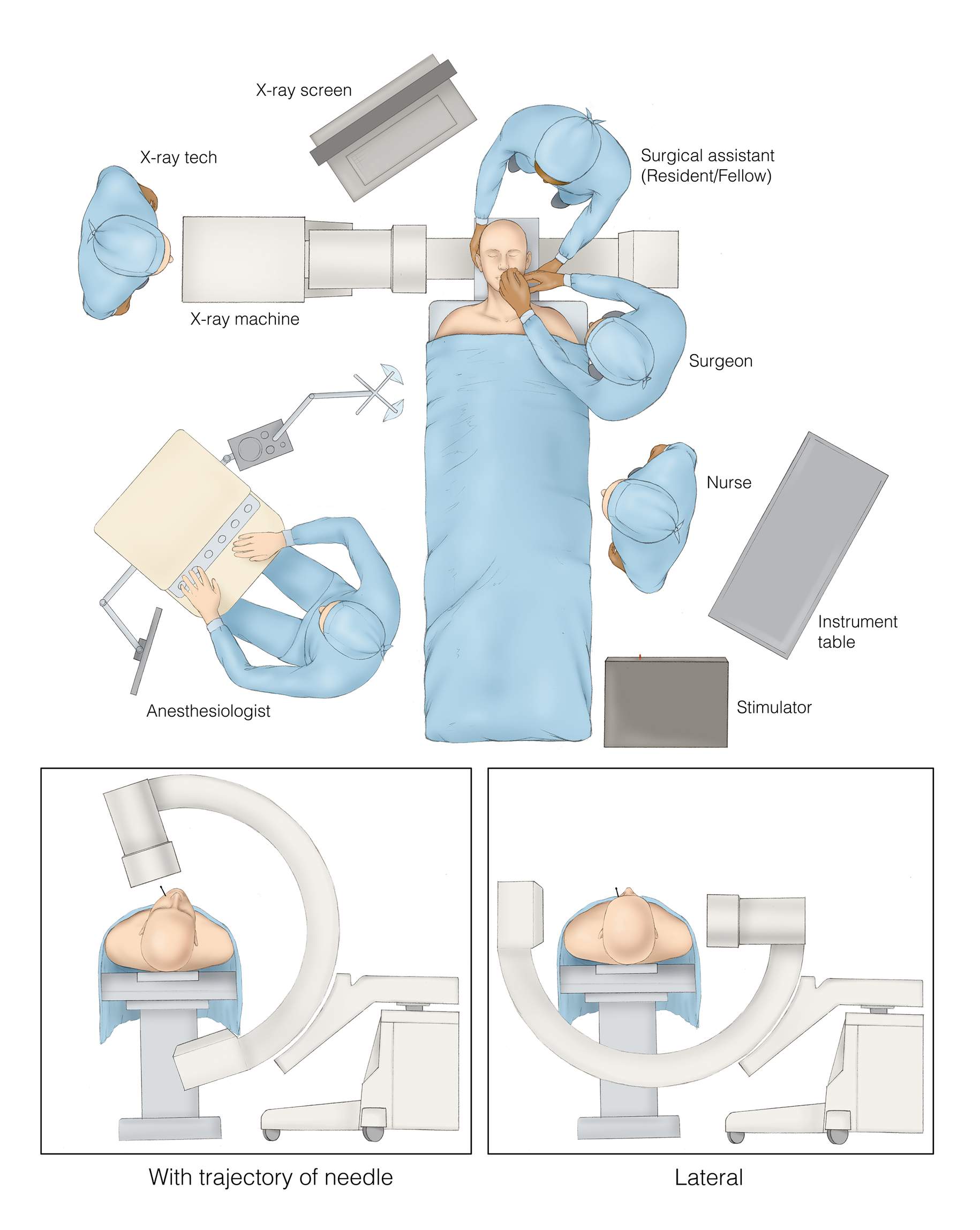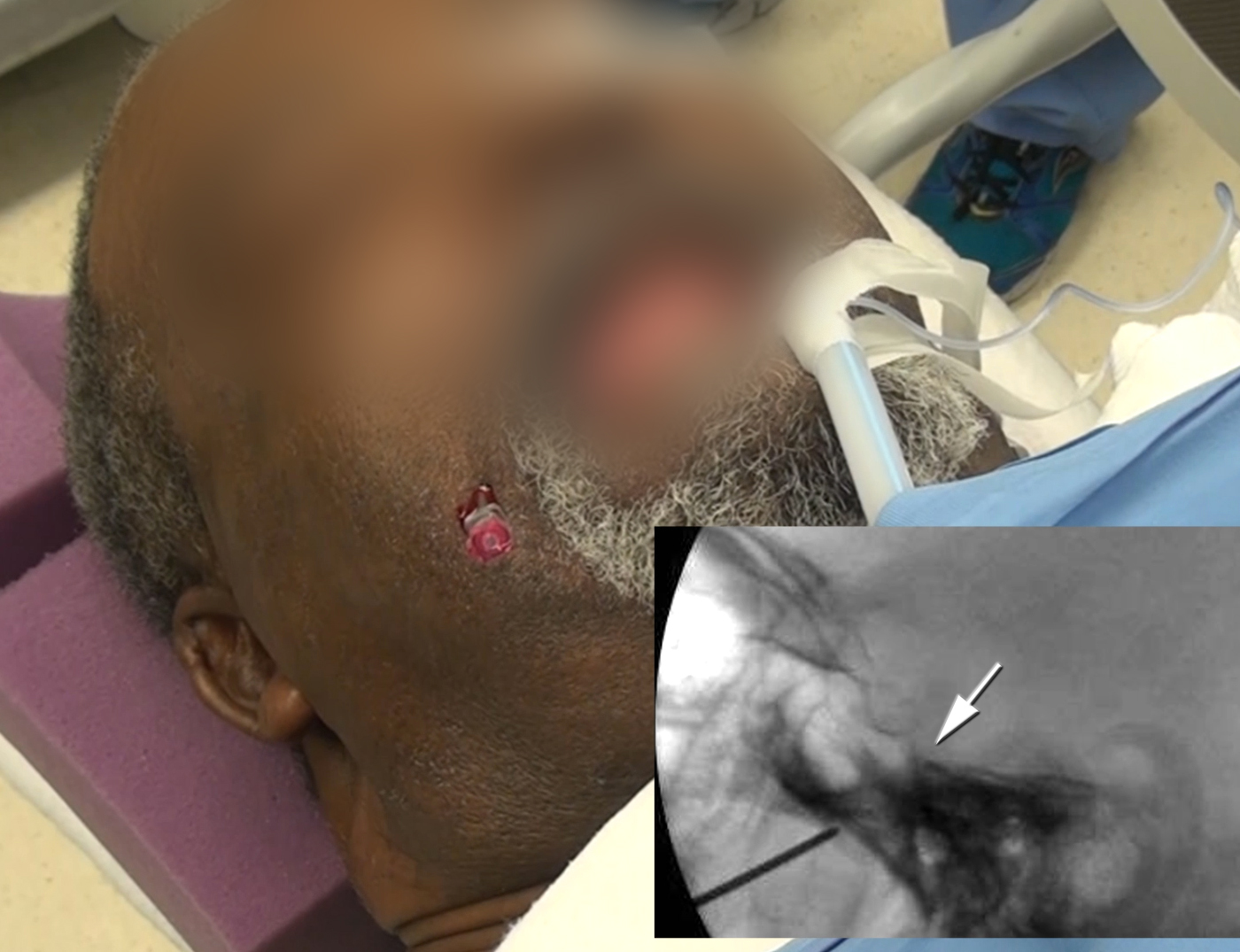Placement of Needle in the Foramen
This is a preview. Check to see if you have access to the full video. Check access
Strategies for placement of the needle or cannula within the foramen ovale
Placement of the needle within the foramen can be challenging because of variations of the foraminal anatomy and the presence of intraforaminal ridges. The experience of the surgeon plays an important role in successful foraminal cannulation.
To complete a successful percutaneous rhizotomy, the foramen ovale must be accessed using Härtel’s technique. This technique is used regardless of the percutaneous modality (balloon compression, radiofrequency lesioning, or glycerol rhizotomy). Performance of a rhizotomy via each modality is discussed separately.
Operative Anatomy
The following images show the relevant anatomy of the foramen ovale.
Click here to view the interactive module and related content for this image.
Figure 1: Osseous anatomy of the middle cranial base. Note the relationship of the foramen ovale to the surrounding foramina and its position when viewed from above (A) and below (B)(Images courtesy of AL Rhoton, Jr).
Figure 2: An oblique view of the pterygomaxillary fissure. Note the relationship of the foramen ovale (arrow) to the lateral pterygoid process and mandibular fossa. The vertical shape of the posterior lip of the foramen may complicate needle entry into the foramen if the needle does not enter the foramen at the appropriate inferior-to-superior trajectory (Image courtesy of AL Rhoton, Jr).
Figure 3: The dissection of the Meckel’s cave and cavernous sinus on the right side after removing the periosteal layer of the dura mater. Placement of the needle or cannula on the medial section of the foramen allows the balloon, electrode, or glycerol solution to make the most contact with the trigeminal roots and enter the trigeminal cistern. Images reproduced with permission from Peris-Celda M, Graziano F, Russo V, Mericle RA, Ulm AJ. Foramen ovale puncture, lesioning accuracy, and avoiding complications: Microsurgical anatomy study with clinical implications. J Neurosurg 2013;119: 1176-1193.
Figure 4: The safe zones and danger zones along the periforaminal space. The green zone defines the safe zones to “walk” the needle along the skull base to find the foramen. The orange zone defines danger zones where the carotid artery or jugular vein could be injured. It is best to aim the needle to enter the region more anteriorly and then adjust the needle tip more posteriorly until the foramen is cannulated.
Figure 5: An oblique radiograph coaxial to the needle aimed at the left foramen ovale (within the dotted outline). Note the approximate locations of the internal jugular vein (blue) and the internal carotid artery (red) in relation to the foramen ovale.
Operating Room Setup
Figure 6: The operating room setup for a percutaneous rhizotomy is shown. The surgeon stands by the patient’s affected side (in this case, left side) and the surgical assistant stands at the head of the table to adjust the patient’s head during fluoroscopy. The anesthesia team is situated across from the surgeon. The stimulator apparatus is by the patient’s feet and cables are passed under the drapes.
A C-arm fluoroscope with an image intensifier is placed around the patient’s head and can be rotated freely to obtain lateral (lower right image) and oblique views parallel to the needle’s long axis (lower left image) as the needle is advanced toward the foramen. Note the position of the patient’s head during these two important imaging sequences; in the latter case, the head is extended. The X-ray viewer is placed across from the surgeon so both the surgeon and assistant can easily view the monitor.
Patient Position
The patient is placed supine on the operating table with a neck roll to achieve a 15- to 20-degree neck extension. The patient’s head is placed in a hollow headrest (“donut gelrest”). More neck extension may disorient the surgeon regarding the landmarks for penetrating the foramen. General anesthesia is administered for balloon compression and glycerol rhizotomies because, unlike radiofrequency lesioning, an awake or cooperative patient is not required for these procedures. The endotracheal tube should be secured on the side contralateral to the affected side of the patient’s face to allow working room in the patient’s mouth for the surgeon’s hand.
For patients undergoing radiofrequency rhizotomy, only light sedation is used because the patient needs to be awake during portions of the procedure. Patient cooperation is critical during the stimulation phase to ensure correct needle tip placement and localization of the radiofrequency rhizotomy lesion. For this reason, uncooperative, overly anxious, or cognitively compromised patients are not suitable candidates for radiofrequency rhizotomy.
Figure 7: Härtel’s anatomic landmarks are used for skin entry and needle trajectory. After injecting local anesthetic, the skin is entered 2.5 cm lateral to the corner of the mouth. The needle trajectory is toward a point in line with the medial ipsilateral pupil and 2.5–3 cm anterior to the external auditory canal. In other words, the needle trajectory is aimed at the intersection of two planes: one sagittal plane passes through the ipsilateral pupil (blue), and the other coronal plane (green) is 3 cm anterior to the external auditory canal.
I place my finger in the oral cavity to ensure that the buccal mucosa is not perforated during needle advancement and to palpate the pterygoid process since the foramen lies lateral to this landmark. I palpate the mandible and advance the needle just medial to it. A bite block may be used to avoid bite injury to the surgeon’s hand. The needle trajectory may be altered using lateral and oblique fluoroscopic views to gain access to the foramen.
If I inadvertently penetrate the mucosa with the needle, I exchange the needle for a new one and use a different submucosal tract to reach the foramen. I do not abort the procedure.
Figure 8: The skull bone is transposed on the patient’s image to illustrate the bony anatomic landmarks used to reach the foramen.
Figure 9: The needle is advanced to reach the ideal position on the lateral X-ray. Note that the tip of the needle is aimed at the junction of the clivus and petrous bone. This is the most important landmark on the lateral fluoroscopic image guiding the surgeon to reach the foramen. The needle tip is advanced onto the junction and upon entering the foramen should rest between 5-15 mm below the sellar floor.
If the needle is not aimed directly at the petrous-clival junction, the needle needs to be repositioned. During repositioning, I withdraw the needle to the skin level and redirect its tip. If the needle is not adequately withdrawn, repositioning will lead to retraction of the mucosae by the needle and resultant deflection of the needle tip. This phenomenon will prevent reliable cannulation of the foramen.
Figure 10: Location of the needle and an intraoperative lateral X-ray (inset) illustrating the final location of the needle near the skull base along the petrous-clival junction (arrow).
After the needle tip has reached the skull base at the desired junction of the clivus and petrous bone, an oblique X-ray with the projection of the X-ray beams coaxial to the long axis of the needle will guide the final minor lateral-to-medial needle tip adjustments to penetrate the foramen. During this oblique imaging, the patient’s head is turned 45 degrees contralaterally and the patient’s neck is extended.
Figure 11: The C-arm is then rotated to offer a tunnel view and the X-rays are beamed in a coaxial manner parallel to the axis of the needle. This view exposes the foramen at an oblique angle and allows exact localization of the needle tip in relation to the foramen. Most often, slight changes in the fluoroscopic beam are required to take a “face-on” image of the foramen. This methodology identifies the foramen between the ramus of the mandible laterally and the maxilla medially.
Figure 12: An oblique X-ray projection relatively parallel to the long axis of the needle demonstrates that the needle tip is just posterior to the foramen (white arrow, left image). Slight adjustment of the needle ensures that the needle is within the foramen (right image).
As the foramen ovale is engaged, a trigeminal depressor response and contraction of the masseter and pterygoid muscles are frequently elicited. In difficult-to-reach foramina, these responses can guide needle placement as I carefully “walk” the needle tip along the safe portion of the skull base to find the foramen. Once the needle enters the foramen, it should be advanced only 0.5 cm until another lateral X-ray confirms the needle position.
Return of cerebrospinal fluid (CSF) after removal of the stylet assures placement of the needle within the Meckel’s cave and Gasserian cistern. This assurance is not required for confirmation of the needle tip location, and the operator should not insist on acquiring CSF in every case except in cases of glycerol injection into the trigeminal cistern. Chances of CSF flow are maximized with the needle hub facing medially.
Penetration of the medial aspect of the foramen ovale is also most desirable because all divisions of the trigeminal nerve can be contacted with this penetration. Lateral needle placement may not allow adequate contact with V1 or V2 divisions. Positioning of the needle should be done with anticipation that the balloon or radiofrequency electrode will extend 5-10 mm beyond the tip of the cannula.
Figure 13: The needle is advanced slightly into the foramen. A lateral fluoroscopic image confirms the final location of the needle tip beyond the skull base (left image). In the case of a balloon compression rhizotomy, the balloon may be inflated within the Gasserian ganglion cistern as demonstrated (right image). The final location of the balloon demonstrates the slight extension of the balloon into the foramen rotundum (blue arrow).
Difficult-to-Reach Foramen
In my experience, there are a few patients (<5%) whose foramen is difficult to cannulate through the submucosal Härtel’s method using fluoroscopy. Any history of significant facial fractures or craniofacial abnormalities should alert the operator to evaluate the bony skull base around the foramen ovale using a preoperative computed tomography (CT) scan to ensure that bony landmarks, including the foraminal anatomy, are not altered.
I often find that the usual oblique angle of needle entry into the foramen will in fact direct the needle tip toward the posterior lip of the foramen. In this situation, the needle should be maneuvered and redirected to enter the foramen in a more inferior-to-superior trajectory. The oral mucosa may interfere with this redirecting and deflect the tip of the needle away from the target. Therefore, I create a different tract within the mucosa to ensure that the needle tip follows my intended trajectory.
Prior difficulty with cannulating the foramen should also prompt a preoperative CT scan of the skull base. Ossified pterygospinous or pterygoalar ligaments or other intraforaminal bony ridges across the foramen will complicate needle entry into the foramen. In such situations, I stereotactically place the needle using intraoperative neuronavigation to accurately navigate the angle of needle penetration.
Figure 14: Note the presence of a bony ridge along the medial aspect of the right foramen ovale at the tip of the black arrow (left image). This ridge will complicate cannulation of the foramen by the needle. Intraoperative CT-guided navigation assisted with placement of the needle in this patient (right image).
Pearls and Pitfalls
- Entrance into the foramen ovale can be difficult because of wide variations in foraminal anatomy. I use lateral and oblique fluoroscopic imaging to guide needle placement.
- Any history of significant facial fractures or craniofacial abnormalities require an evaluation of the bony skull base around the foramen ovale using a preoperative CT scan to ensure that bony landmarks, including the foraminal anatomy, are not altered.
- The needle should not be forced to enter the skull base as this maneuver will lead to precarious needle locations and resultant cerebrovascular injury.
Please login to post a comment.

